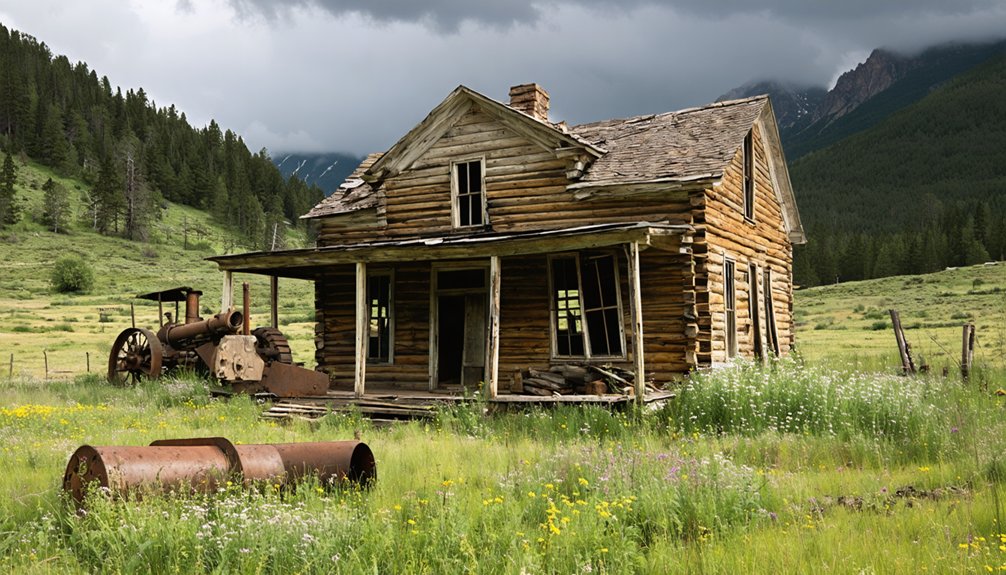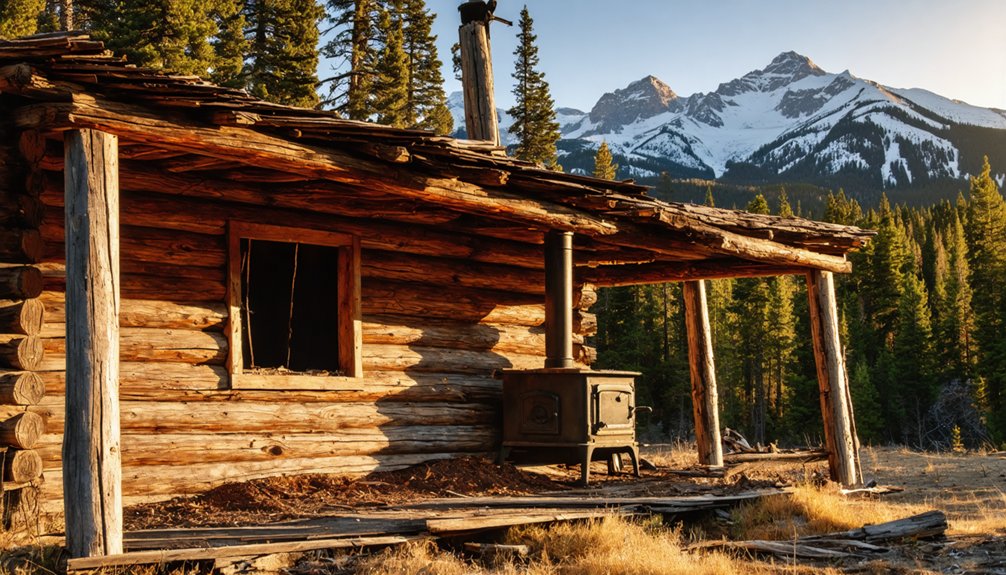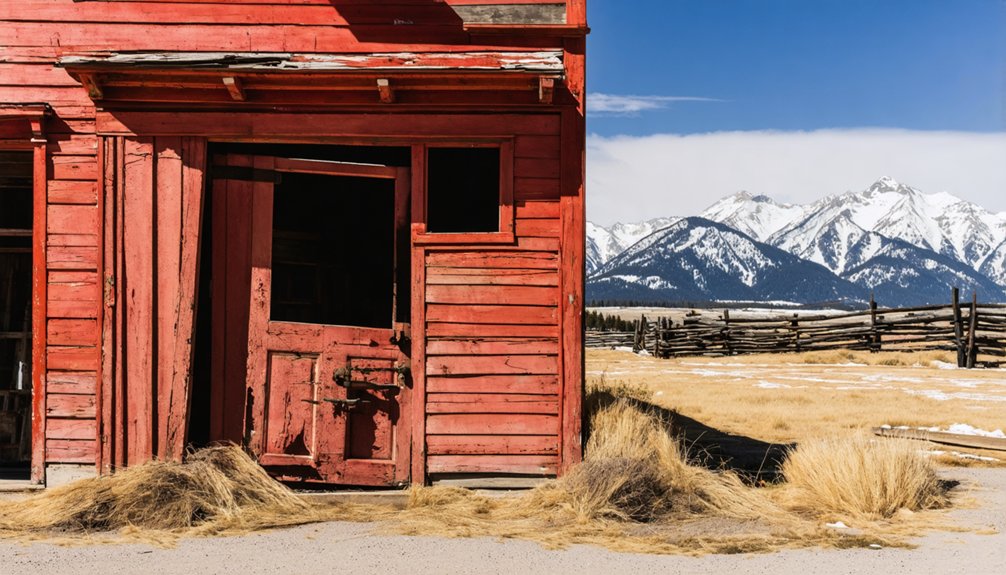You’ll find Williamsville perched at 9,500 feet in Colorado’s Rockies—a silver boomtown that thrived briefly in the 1870s. Irish immigrants and diverse workers flocked here after rich silver-lead ore discoveries, building a community with stores, saloons, and the Kalamazoo Hotel. When silver prices collapsed in 1893, the town emptied. Today, weathered wooden structures stand as silent sentinels along difficult County Road 20, telling tales of frontier boom and bust.
Key Takeaways
- Williamsville transformed from a silver boomtown in the 1870s to a ghost town after the 1893 repeal of the Sherman Silver Purchase Act.
- The abandoned town showcases mining infrastructure including gravity-fed mills, pump houses, and the foundations of the Kalamazoo Hotel.
- Life in Williamsville centered around mineral extraction with miners working before dawn and families living in company-owned housing.
- Several structures have been designated for historical preservation by the Colorado Historical Society, highlighting the town’s mining heritage.
- The best time to visit the remote ghost town is between late June and early October due to harsh mountain weather conditions.
The Birth of a Silver Boomtown (1870s)
Three vital factors converged in the 1870s to transform Williamsville from untouched mountain terrain into a thriving silver boomtown.
First, prospectors discovered carbonate silver-lead ores similar to nearby Leadville’s deposits, triggering immediate mining investments from enthusiastic capitalists. The Bland-Allison Act significantly increased the value of these discoveries, making previously unprofitable mining operations economically viable.
Second, Colorado’s statewide silver rush created infrastructure momentum that Williamsville leveraged, including essential railroad connections for transporting ore and supplies.
Finally, a diverse workforce flocked to the area, with Irish immigrants forming a substantial portion of the labor force. Similar to U.S. Senator Henry Teller‘s support for the silver industry, local politicians championed Williamsville’s mining interests.
You’d have witnessed a remarkable transformation as sawmills, blacksmiths, and general stores sprouted alongside mines, creating a complete community almost overnight.
Williamsville’s emergence mirrored other Colorado boomtowns like Aspen and Crested Butte, all participating in the silver bonanza that would fundamentally reshape the mountain landscape.
Life at 9,500 Feet: Williamsville’s Mountain Setting
You’d have battled brutal temperature swings at Williamsville’s 9,500-foot elevation, where summer afternoons quickly surrendered to freezing nights and winter storms could isolate the community for weeks.
The thin mountain air made every mining task more strenuous, forcing residents to develop stronger lungs and hearts just to perform daily work. This high-altitude challenge was common among Colorado’s forty municipalities situated above 8,000 feet. Like other high-elevation communities, Williamsville’s yearly temperature likely averaged just above freezing, similar to the top 11 highest cities in the U.S.
Cut off by steep terrain and heavy snowfall, Williamsville’s community forged tight bonds through self-reliance, creating a distinctive mountain culture where neighbors relied on each other for survival through the harshest conditions.
Extreme Weather Challenges
Life at Williamsville’s lofty elevation of 9,500 feet presented residents with weather challenges that most lowland settlers never had to face.
You’d experience bone-chilling temperature swings—daytime highs barely reaching 40-50°F in winter, while nights plunged into single digits due to radiational cooling through the thin atmosphere.
Unpredictable storms arrived without warning, bringing intense snowfall from September through May.
You’d contend with gusty mountain winds reaching 30+ mph, amplifying the already brutal cold and complicating daily tasks.
The thin air made heating your home difficult and expensive, while increasing your UV exposure despite frigid conditions.
You needed constant vigilance—spring thaws triggered flooding, summer brought lightning-sparked fires, and autumn’s rapid temperature drops meant early preparation for the next harsh winter cycle.
Isolation Shapes Community
Nestled high in the San Juan Mountains at 9,500 feet, Williamsville’s extreme isolation has forged a community unlike any found in more accessible parts of Colorado.
You’ll find only a handful of year-round residents braving the challenges of this remote setting, where County Road 20 becomes impassable for months during winter storms.
This geographic seclusion has nurtured remarkable community resilience. Neighbors share resources, assist with emergency needs, and maintain traditions that might otherwise fade.
Without commercial businesses or regular visitors, residents depend on each other in ways forgotten in modern society.
The cultural preservation that results is striking. Local customs and oral histories survive intact, preserved by limited outside influence. The town is located in the Front Range region, offering residents stunning mountain vistas despite the challenges of high-altitude living.
While isolation has stunted economic development, it’s simultaneously protected Williamsville’s authentic mountain heritage and self-reliant spirit. It’s important to note that this area, like many with the name “Williamsburg,” requires disambiguation to distinguish it from similarly named locations across the country.
Silver Strikes and Mining Operations
You’d witness Williamsville’s dramatic boom and bust cycle firsthand, as miners extracted rich silver ore from veins discovered in the late 1870s.
Working the underground shafts at 9,500 feet presented extraordinary challenges, with harsh winters, limited infrastructure, and primitive tools testing miners’ determination daily. Like many operations throughout the region, these mines relied on geological formations that created ideal conditions for valuable mineral deposits.
When silver prices collapsed after the 1893 repeal of the Sherman Silver Purchase Act, once-profitable mines quickly shuttered, transforming a thriving community into the ghost town that stands today. This pattern mirrored the larger Colorado silver boom that began in 1877 and saw mining towns like Leadville grow from 200 to over 15,000 residents in just two years.
Boom and Bust Cycle
When silver ore was first identified in Colorado in the 1860s, few could have predicted the explosive boom-and-bust cycle that would transform places like Williamsville into bustling centers of activity before ultimately abandoning them to history.
Like many silver mining towns, Williamsville experienced rapid growth as railroad connections facilitated industrial-scale operations.
You’d have witnessed populations exploding from hundreds to thousands within months as miners, merchants, and opportunists flooded in seeking fortune. The wealth generated from these operations contributed significantly to regional modernization and infrastructure development throughout Colorado.
This prosperity proved tragically temporary.
When the Sherman Silver Purchase Act was repealed in 1893, silver prices collapsed overnight.
The economic fluctuations devastated communities as mines closed, leaving families no choice but to evacuate. After the Brunot Agreement of 1873, mining activities had flourished on former Ute lands that were sold off from indigenous reservations.
Banks shuttered, property values plummeted, and once-thriving settlements emptied—creating the ghost towns you can explore today.
Rich Ore Deposits
The silver that transformed Williamsville from wilderness to boomtown lay hidden for millennia in some of Colorado’s richest ore deposits before prospectors recognized its value.
You would’ve found these treasures primarily in the Mississippian Leadville Limestone and Pennsylvanian Belden Formation, where galena, sphalerite, and native silver awaited discovery.
When cerussite silver ore was struck in the mid-1870s, it triggered one of the region’s most explosive mining booms.
Geological surveys mapped outcrops and mineralogical indicators, directing strategic mineral exploration throughout the area.
Mining operations quickly scaled to process over 100 tons of ore daily, with innovative crushers extracting fine silver particles from even low-grade material.
The polymetallic nature of these deposits—silver mixed with lead and zinc—required specialized extraction methods, but yielded extraordinary wealth that built a town virtually overnight.
Challenging Mining Conditions
Despite the promise of riches that initially drew miners to Williamsville, extracting silver from these mountains came with formidable challenges that tested both men and machines.
You’d face constant environmental challenges – frequent fires swept through mining operations, destroying critical infrastructure, while unpredictable flooding forced the abandonment of numerous promising mines.
The economic landscape proved equally treacherous. Silver prices fluctuated wildly before collapsing entirely during the Panic of 1893, transforming profitable operations into financial liabilities overnight.
Mining hazards multiplied with the complex composition of local ores, which contained mixtures of silver, lead, gold, zinc, and copper requiring specialized processing techniques.
The remote location further complicated matters, as limited transportation infrastructure made shipping ore to distant smelters costly and inefficient, greatly reducing profits from all but the highest-grade deposits.
Daily Life in a Remote Mining Community

Life in Williamsville during its mining heyday revolved almost entirely around the harsh realities of mineral extraction. You’d rise before dawn, trudging to the mines where men and boys as young as 10 labored in dangerous conditions, facing potential floods and fires.
Welsh, Irish, German, and Italian families crowded into company-owned housing, where women maintained households while men worked punishing shifts.
Despite these challenges, community resilience flourished through shared cultural traditions. You’d find comfort in religious gatherings and social events that momentarily eased the labor struggles defining daily existence.
The railroad brought essential supplies but also tied your fate to distant markets. When mines closed temporarily, you’d feel the immediate economic impact.
Water, food, and basic necessities often came at premium prices from company stores, creating a cycle of dependency that defined life in this remote mountain settlement.
The Buildings and Businesses of Williamsville
As you walk through Williamsville today, you’ll notice the remaining rough-hewn homes, cabins, and the distinctive red-cedar water tank that reflect the practical needs of frontier mining life.
The town’s commercial hub, though limited, once featured essential services including a post office, general stores, and several saloons that served the social and practical needs of miners.
Many original structures have deteriorated over time, leaving only traces of the once-bustling mine infrastructure that included a hydroelectric mill powered by Henson Creek and nearby facilities like the Tomboy Mine.
Rough-Hewn Pioneer Structures
The rough-hewn buildings of Williamsville stand as evidence to pioneer ingenuity and resourcefulness in the face of frontier challenges.
You’ll notice the structures built entirely from local timber and logs, with simple designs that prioritized function over decoration. Pioneer craftsmanship is visible in the hand-cut lumber and careful chinking between logs that protected residents from Colorado’s harsh mountain climate.
Stone foundations adapted to the uneven terrain, while wooden-shingled gabled roofs topped most structures.
The rustic aesthetics weren’t stylistic choices but necessary adaptations to limited resources. Many buildings served dual purposes—homes doubling as workshops, stores housing post offices—reflecting the practical nature of frontier life.
These weather-beaten structures represent the last physical connections to a community that thrived through self-reliance, determined to carve civilization from wilderness.
Commercial Hub Limitations
Despite Williamsville’s ambitions, the town’s commercial sector never expanded beyond a modest collection of essential businesses that served the immediate needs of local miners and their families.
You’d have found a single general store stocking basic provisions, a small assay office, and a rudimentary saloon where weary workers gathered after long shifts underground.
Unlike successful mining communities that developed robust commercial infrastructure, Williamsville lacked the capital investment needed to establish sustainable enterprises.
The absence of a dedicated bank or significant mercantile establishments hampered economic growth, keeping the settlement perpetually on the edge of viability.
When silver prices collapsed in the 1890s, the town’s already limited commercial footprint began its rapid contraction, accelerating the economic decline that would ultimately transform Williamsville into the silent ghost town you can explore today.
Abandoned Mine Infrastructure
Walking among Williamsville’s silent ruins today, you’ll find a remarkable collection of abandoned mining infrastructure that tells the story of this once-bustling frontier community.
The ghostly remnants include the gravity-fed Gold Prince mill with its tiered foundations designed for innovative mining techniques that utilized gravity flow for ore processing.
You can still identify pump houses, compressor stations, and mini powerhouses that once powered the mining operations.
The well-preserved wooden structures with their 6-inch thick plank walls—including the historic jail—stand as evidence of frontier ingenuity.
Nearby, you’ll discover the foundations of the Kalamazoo Hotel, once the town’s crown jewel featuring the only telephone.
The scattered remnants of warehouses and tramways complete this portrait of a community that thrived on mineral wealth before fading into history.
The Silver Crash of 1893 and Its Impact
When silver prices plummeted in 1893, they triggered a catastrophic chain reaction that would forever alter Williamsville’s destiny. The government’s repeal of the Sherman Silver Purchase Act sent prices crashing, forcing the mine operators to shutter operations virtually overnight.
You’d have witnessed economic repercussions ripple through every aspect of town life—banks collapsed, businesses closed, and property values evaporated.
Labor struggles defined this dark period as nearly half of Williamsville’s workforce lost their livelihoods. Miners faced an impossible choice: accept dramatic pay cuts or join the exodus from town.
Many families packed onto outbound trains, abandoning homes they could no longer afford. While the national Panic of 1893 devastated communities across Colorado’s mining regions, Williamsville’s dependence on silver left it particularly vulnerable, transforming a once-thriving settlement into the ghost town you see today.
Abandonment and the Ghost Town Years

The exodus from Williamsville following the silver crash ushered in an era of abandonment that would span generations. As residents departed in waves between 1893 and 1896, distinctive abandonment patterns emerged. Families left first, followed by merchants, and finally the most determined miners who clung to fading dreams of silver’s return.
What remained became the silent evidence to Colorado’s boom-and-bust mining legacy.
- Ghost town legends tell of the “Williamsville Watchman,” a former miner who allegedly stayed until 1912, maintaining the abandoned general store as if customers might return any day.
- Winter snowfall occasionally still reveals foot tracks between former residences, fueling visitor speculation about supernatural presence.
- The town’s weathered structures have resisted complete collapse longer than most ghost towns, creating an unintentional monument to frontier resilience.
What Remains Today: Ruins and Remnants
Visitors to Williamsville today encounter a haunting tableau of weathered structures that have defied both time and Colorado’s harsh elements for well over a century.
These remnants offer a tangible connection to the past through thoughtful ruins exploration, inviting you to step back into the town’s mining heyday.
Step into Williamsville’s ghostly embrace, where each crumbling cornerstone whispers stories of mountain prosperity long vanished.
The Colorado Historical Society has designated several structures for historical preservation, marking them with informative plaques that tell the story of their original purpose.
You’ll find partially collapsed wooden cabins, stone foundations where homes once stood, and the weathered timber frames of what was once the town’s small commercial district.
The rusting machinery scattered throughout serves as silent testimony to the industrial ambitions that briefly transformed this remote mountain valley.
Reaching Williamsville: a Journey Into the Past

Journeying to Williamsville offers more than just a chance to view historic ruins—it’s an adventure that mirrors the challenges faced by the miners and settlers who first carved this remote outpost from the wilderness.
You’ll need to travel Highway 550 to Silverton, then navigate the historic Engineer Pass Road (CR 20), following the same rugged path used by prospectors in the 1880s.
- The final stretch requires hiking or off-road vehicles, as the trail becomes impassable for standard transportation—a physical reminder of Williamsville’s isolation.
- Visit between late June and early October when mountain passes are free of snow and historical landmarks are fully visible.
- Carry extra supplies and start early; the driving tips from a century ago still apply: prepare for self-sufficiency in this untamed landscape.
Preserving Colorado’s Mining Heritage
While Williamsville’s crumbling structures tell one chapter of Colorado’s mining saga, they represent just a fraction of the state’s rich industrial heritage now facing preservation challenges.
Over 23,000 hazardous mining features remain unsafeguarded across Colorado, with limited funding available for heritage conservation efforts.
You’ll find preservation isn’t just about protecting old buildings—it’s an economic engine. Every $1 million invested creates 32 new jobs, with preservation projects generating $2.5 billion in economic impact since 1981.
When you visit historic mining districts in Idaho Springs or Silverplume, you’re experiencing living history that drives tourism.
Mining education initiatives like “Stay Out and Stay Alive” balance public safety with cultural appreciation, inviting you to explore this legacy through museums rather than dangerous abandoned sites.
Community involvement remains vital to preserving these stories.
Frequently Asked Questions
Were There Any Notable Disasters or Accidents in Williamsville’s History?
You’ll find Williamsville’s history marred by mining accidents like tunnel collapses and silicosis, plus natural disasters including the devastating 1891 fire, toxic pollution evacuation in 1984, and the paralyzing 23-day blizzard of 1884.
Did Any Famous or Noteworthy Individuals Ever Visit Williamsville?
While you’d expect famous visitors given its historical significance, there’s no documented evidence of remarkable individuals visiting Williamsville. Local records don’t mention any celebrities or dignitaries traveling to your community during its brief existence.
What Indigenous Tribes Inhabited the Area Before Mining Began?
You’ll find that the Ute Tribe maintained long-standing presence in this mountain region, while Cheyenne peoples traversed the area seasonally for hunting and resource gathering before mining operations displaced them.
Has Williamsville Ever Been Featured in Films or Television Shows?
Based on available research, you won’t find any documented film references or television appearances featuring Williamsville. Unlike other Colorado ghost towns that have attracted Hollywood’s attention, Williamsville remains authentically undisturbed by the entertainment industry.
Are There Any Legends or Ghost Stories Associated With Williamsville?
You’ll find no documented ghostly encounters or local folklore connected to Williamsville. Unlike other Colorado ghost towns, it lacks supernatural tales, possibly due to its brief existence and unremarkable closure.
References
- https://www.explore.com/1704724/get-lost-mysterious-colorado-independence-ghost-town-history-ruins/
- https://www.colorado.com/articles/colorado-ghost-towns
- https://en.wikipedia.org/wiki/List_of_ghost_towns_in_Colorado
- https://www.youtube.com/watch?v=CCXuJJiQDfA
- https://coloradorealty-experts.com/three-of-colorados-most-popular-ghost-towns/
- https://coloradosghosttowns.com/Lamartine Colorado.html
- https://www.coloradolifemagazine.com/blog/post/colorado-mining-history
- https://en.wikipedia.org/wiki/Colorado_Silver_Boom
- https://www.aspentimes.com/news/colorados-silver-and-gold-rushes-just-kept-on-rushing/
- https://www.townoflakecityco.gov/gold-silver-booms-in-colorado



